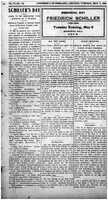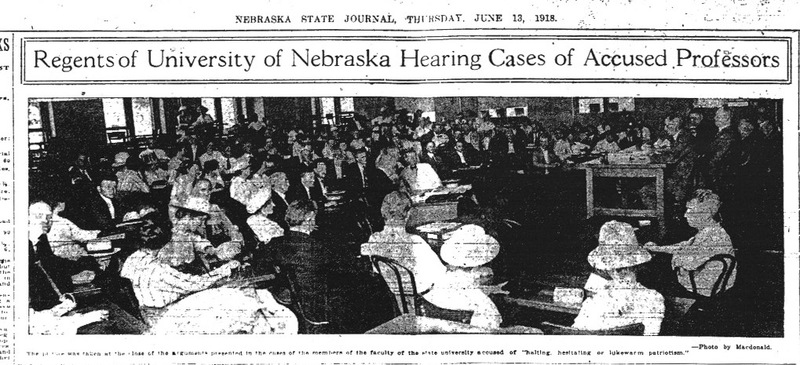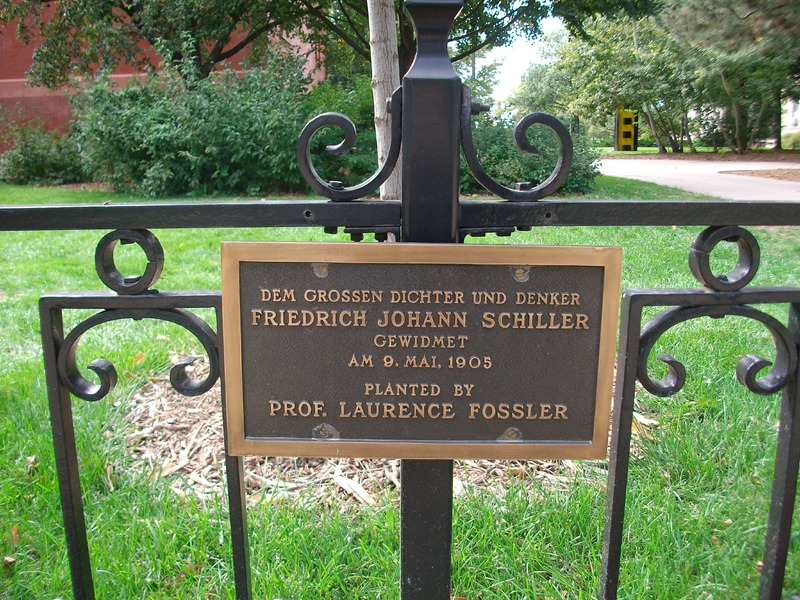The Schiller Linden Tree
Credits
Editors: Aaron Kern and Emily Heineman, History 189H: Memory, Memorials, and History, Fall 2010
This exhibit chronicles the history of the Schiller Linden tree planted by professor of German language Laurence Fossler and the events surrounding its defacement and replacement.
Planting the Seeds: Fossler and the Schiller Linden Tree
Laurence Fossler served as professor of German language at the University of Nebraska from 1889 to 1926. His work interpreting, translating, and writing material for use in classroom is part of his lasting legacy on the University's campus and throughout academia.
Born in Würtemburg, Germany, Fossler immigrated to the US in 1872 at age 15, speaking no English. He attended the University, graduating in 1881, and traveled back to Europe for a year of study at the University of Paris and Berlin. Upon his return to Nebraska he took a teaching position at Lincoln High School and, in 1889, received an offer to teach German at the university. By 1891, German had become so popular that the subject was given its own department, of which Fossler was in charge.
When World War I broke out, interest in German language and culture dropped sharply. The Romantic Language department absorbed the German department. After the end of World War I, the German language program gained renewed attendance, becoming the second largest department in the University (Fling, 1933)
Fossler, beloved by his students and follow professors, alike, received the honor of having all classes dismissed upon his death in 1933. (Thompson, 1933).
On June 12, 1905, Fossler wrote the Board of Regents concerning his plan to plant the Schiller Linden tree. The tree and its plaque were intended to be an homage to the linden-lined street in Berlin, Germany, known as "Unter dem Linden" or "Under the Lindens." Fossler explained to the Board that the funds for the tree, fence, and the plaque were paid for mostly by the German residents of Lincoln and that the plaque had been designed by a student by the name of Lillian Rudersdorf (Fossler, 1905).
Uprooting the Tree: WWI
When war broke out in Europe in 1914, anti-German sentiment was almost non-existent, particularly in the state of Nebraska. Over the next year, anti-German sentiment began to rise due to increased hostility by German U-boats towards American vessels, and was cemented into place by the sinking of the RMS Lusitania on May 7th, 1915. By the time America entered the war on April 6th, 1917, domestic hostility towards Germans and German culture had reached a fever pitch. Within a month of America entering the war in Europe, the Nebraska Legislature passed a bill which created the Nebraska State Council of Defense. (Manley)
The Nebraska State Council of Defense was created to ensure that the state would be the most effective at serving the nations objective of victory in Europe. The primary objective that the council stressed to enforce was a state loyalty to the national agenda. The Nebraska Council of Defense targeted various organizations, including churches and schools, to eliminate the use of the German language. (Manley) While these acts are now seen as inexcusable abuse of power, the Nebraska Council of Defense would be known for the infamous loyalty trials that it demanded at the University of Nebraska.
Disagreement over America's involvement in the war existed on the University of Nebraska campus from the outset. Within several days of America joining the war, two petitions were circulating through the university staff. One stressed patriotism and loyalty to the nation to help achieve victory in Europe, the other petition stated that peace and neutrality were the methods most imperative for America to prosper. Many of the professors that signed the second petition, including Professors Caldwell, Wolfe, Persinger, and Mary Fossler, daughter of Laurence Fossler, would later be put on trial on charges of disloyalty. Professor Laurence Fossler met with the Nebraska Council of Defense as early as November, 1917, but was not initially put on trial, due to how well he handled initial questions from the council about his views of Germany and German culture. (Manley)
Demanded by the Nebraska Council of Defense and executed by the University Board of Regents, the loyalty trials took place from May 28th through June 19th, 1918. There was no restriction on the evidence that was presented in the trials, so hearsay constituted almost all of the evidence presented against the accused. In the end, the Board of Regents acquitted almost all of the professors on the grounds that there was no concrete evidence to prove they harbored any disloyalty to the United States. Only several of the accused professors were directed to turn in their resignations, and this was more for their lack of discretion and professionalism rather than disloyalty. Professors Fling and England, the two professors who primarily started the on-campus feud within the faculty, were also directed to resign, although they were allowed to appeal this decision at a later time. (Manley)
Though in the end relatively little ever became of these trials, the damage was done to the University of Nebraska’s reputation. Over the course of time this era was generally forgotten by the university and the public. Though America would go to war with Germany again within the next twenty-five years, anti-German sentiment was nowhere near as prevalent as it was during World War I.
Resowing the Seeds: A New Plaque
In 1938, Victor Graham, an alumnus of the university, wrote to Clara Craig, recounting the defacement of the original Schiller Linden tree plaque and inquiring if the plaque had been restored. Craig then wrote to Dean Henry H. Foster in order to answer Graham's question. Foster's reply is kurt, stating, "The plate has been restored to its place. I know nothing concerning its history. Its restoration ought to conclude an unpleasant incident in our university annals." Craig noted at the bottom of the letter, "The plate on the tree is a replacement, not the original plate restored" (Craig, 1938). The whereabouts of the original Schiller Linden tree plaque are a mystery to this day. The replacement was dedicated in 1933, after Fossler's death, in a ceremony presided over by Fossler's life long friend Fred Morrow Fling (Daily Nebraskan, 1933).
Today, the wounds of anti-German sentiment are healed and few recall the loyalty hearings of World War I. The Schiller Linden tree stands proudly on UNL's campus as a testament to Fossler and Lincoln's German community's impact on the development of the university. War, hysteria, and fear mongering led to innocent Americans being demonized and prosecuted. A beautiful symbol of international unity was destroyed out of xenophobia and intolerance. This era in the university's history is an ugly one, but the episode can be used to teach future generations about acceptance.
- Clara Craig, Lincoln, NE, to Henry H. Foster, Lincoln, NE, 19 February, 1938. UNL Building and Grounds, box 20, folder 1, University Archives and Special Collections, University of Nebraska-Lincoln.
- Knoll, Robert E. "Prairie University" Lincoln, Nebraska: University of Nebraska Press,1995. 223 pp.
- Laurence Fossler, Lincoln, NE, to the Chancellor and Board of Regents, 12 June, 1905. Board of Regents papers, box 17, folder 4, University Archives and Special Collections, University of Nebraska-Lincoln.
- Manley, Robert Neal. "The Nebraska State Council of Defense: Loyalty Programs and Policies During World War I." University of Nebraska: August, 1959. 302 pp.
- "Reagents Board Hearing Charges of the State Council." The Lincoln Star, 28 May, 1918.
- "Reagents of University of Nebraska Hearing Cases of Accused Professors." The Nebraska State Journal, 18 June, 1918.
- "A Romance-- 'aus Zwei Welton'" November, 1932., Dr. Fred Morrow Fling. U.N. Biographical/Bibliographical Files, box 91, folder 1, University Archives and Special Collections, University of Nebraska-Lincoln.
- "Schiller's Day." The Daily Nebraskan, 9 May , 1905.
- "The Schiller Festival." The Daily Nebraskan, 6 May, 1905.
- T. J. Thompson, Dean of Student Affairs, to Officers of Instruction, University of Nebraska-Lincoln, U.N. Biographical/Bibliographical Files, box 91, folder 1, University Archives and Special Collections, University of Nebraska-Lincoln.
- Victor Graham, Omaha, NE, to Clara Craig, Lincoln, NE, 25 January, 1938. UNL Building and Grounds, box 20, folder 1, University Archives and Special Collections, University of Nebraska-Lincoln.





